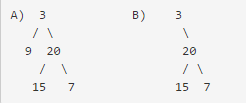Problem description:
level: medium
Given a binary tree, determine if it is height-balanced.
For this problem, a height-balanced binary tree is defined as a binary tree in which the depth of the two subtrees of every node never differ by more than 1.
Example
Given binary tree A={3,9,20,#,#,15,7}, B={3,#,20,15,7}

The binary tree A is a height-balanced binary tree, but B is not.
Solution:
consider a node, if left is balanced, right is balanced, and left, right nodes height difference < 2, then the node is balanced
Another thought:
if a node is not balanced, then its height set to -1
else return it is real height
Using Divide & Conquer, we can get the height to decide if it is a balanced tree
|
1 2 3 4 5 6 7 8 9 10 11 12 13 14 15 16 17 18 19 20 21 22 23 24 25 26 |
/** * @param root: The root of binary tree. * @return: True if this Binary tree is Balanced, or false. */ public boolean isBalanced(TreeNode root) { if(root == null) return true; boolean left = isBalanced(root.left); boolean right = isBalanced(root.right); int leftHeight = maxHeight(root.left); int rightHeight = maxHeight(root.right); return left && right && Math.abs(leftHeight - rightHeight) < 2; } public int maxHeight(TreeNode root) { if(root == null) return 0; int left = maxHeight(root.left); int right = maxHeight(root.right); return Math.max(right, left) + 1; } |
Time complex: O(n)








